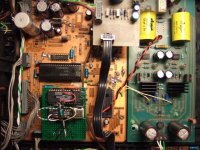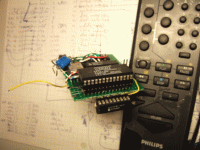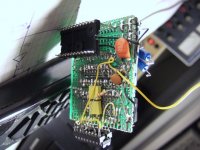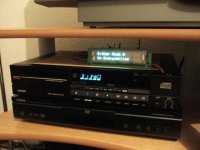Unfortunately i live some distance away, otherwise i would like to come over for some beers an listening to you guy's there in UK😉
tubee said:Unfortunately i live some distance away, otherwise i would like to come over for some beers an listening to you guy's there in UK😉
At the first UK meet (summer last year) we had no fewer than TWO guys over from Holland! 😎
Well, if you get this far, I'll happily introduce you to Bath Ales and Abbey ales at the most excellent Star Inn - my local 🙂
Hi folks. This one's really for the beginners who may be lurking, wondering about the location of these important parts.
The heatsink on the lower regulator is needed because the digital filter (SAA7220) draws a lot of current.
Brent installed the C1 and its reg for me, very neatly! I did the rest 😎
Simon
The heatsink on the lower regulator is needed because the digital filter (SAA7220) draws a lot of current.
Brent installed the C1 and its reg for me, very neatly! I did the rest 😎
Simon
Attachments
Yesterday I did some tiny tweeks, but every little helps 😎
1) "terminated" the digital coaxial output with an 82R resistor across an RCA plug
2) ran the Densen DeMagic track
No comment re. the sound, like I say it all adds up 😀
Comparing the 650 to a CD63SE with 2 clocks, op-amps and new caps today it's clearly wanting more detail, space and openness.
I might do some low-risk / easy mods next, like shielding the ICs. I also think this player might be deserving of some proper output caps and sockets (that means CMC silver over copper RCAs and Munforf Supreme).
Simon
1) "terminated" the digital coaxial output with an 82R resistor across an RCA plug
2) ran the Densen DeMagic track
No comment re. the sound, like I say it all adds up 😀
Comparing the 650 to a CD63SE with 2 clocks, op-amps and new caps today it's clearly wanting more detail, space and openness.
I might do some low-risk / easy mods next, like shielding the ICs. I also think this player might be deserving of some proper output caps and sockets (that means CMC silver over copper RCAs and Munforf Supreme).
Simon
You have a nice time with that few £ toy isn't it?😉
I am playing now with the pcm56's, and don't regret i do 😀
I am playing now with the pcm56's, and don't regret i do 😀
Yeah, it's fun and I like to see them "grow up" and finally sound "good". The only trouble is knowing this won't be my "last" CD player ever so how much do I spend on it? Funds are not limitless, but I can recycle parts I suppose!
I've not seen many CD650s on the 'net so I might be able to strive for "best CD650 in the world"... after installing some power supplies, more regulators and losing the dirty old output sockets.
I would also like to look at alternative output stages (easy ones, not tubes!), but I'm not about to design a circuit.
Simon
I've not seen many CD650s on the 'net so I might be able to strive for "best CD650 in the world"... after installing some power supplies, more regulators and losing the dirty old output sockets.
I would also like to look at alternative output stages (easy ones, not tubes!), but I'm not about to design a circuit.
Simon
Familiar output stage Guido😉
Yes i have the same problems here Simon (funding my hobby )
)
Oh yes if you want to try a good I/V stage: maybe Pedja's AD844 I/V ? Have build and tried it.
Yes i have the same problems here Simon (funding my hobby
 )
)Oh yes if you want to try a good I/V stage: maybe Pedja's AD844 I/V ? Have build and tried it.
tubee said:Familiar output stage Guido😉
Yes i have the same problems here Simon (funding my hobby)
Indeed, but the cheaper cd40 version. Only this is modded a bit, pooge AD811. Hence the cooling. No more 5534 😉
Messy?, looks neat Guido, unfortunately my wife took the cam with her, could have shown where i am now listening at.... 

" Funds are not limitless, but I can recycle parts I suppose!"
The challenge of doing this on a shoestring is half the fun I think.
It gives me immense pleasure having a decent CD player that cost a tenth of what my mate spent 😀
For a simple IV stage, you could try the opamp circuit shown in the TDA1541A datasheet, followed by the passive filter Ray used in his CD63. I use that at the moment, and it seems to work fine. I think it either needs a buffer output stage, or the filter made active to drive all possible preamp stages, but it works well in most scenarios.
The challenge of doing this on a shoestring is half the fun I think.
It gives me immense pleasure having a decent CD player that cost a tenth of what my mate spent 😀
For a simple IV stage, you could try the opamp circuit shown in the TDA1541A datasheet, followed by the passive filter Ray used in his CD63. I use that at the moment, and it seems to work fine. I think it either needs a buffer output stage, or the filter made active to drive all possible preamp stages, but it works well in most scenarios.
philpoole said:
For a simple IV stage, you could try the opamp circuit shown in the TDA1541A datasheet, followed by the passive filter Ray used in his CD63. I use that at the moment, and it seems to work fine. I think it either needs a buffer output stage, or the filter made active to drive all possible preamp stages, but it works well in most scenarios.
I reckon I'll have a go at this in my CD94 later on today. How do you find the gain of this setup?
I currently use the players standard I/V stage with caps removed as they were attenuating the treble, fed into Ray's discrete output, same as cd63. The problem I have is that the signal going into the discrete output stage is way too quiet.
Nice work btw Simon. I'm glad you're being converted to TDA sound.
Cheers, Lee.
philpoole said:"
The challenge of doing this on a shoestring is half the fun I think.
That's how I started
 LOL
LOLBrent
That's deliberate, for several reasons bu mainly because:I currently use the players standard I/V stage with caps removed as they were attenuating the treble
1) It stops the opamp going into slew limiting for HF noise in the dac's output. The effect is greatly reduced distortion.
2) The SAA7220 has a not-very-well documented rise in response, it's 1dB up at 20Khz.
So the elegant solution is to pick a cap across the feedback resistor so that the impedance of (Rf // cap) is 1dB down at 20Khz. Pick the resistor value you want to give the output level you need, then calculate the cap required (usually in range 1-2nF). That gets you a flat frequency response to 20Khz, after which you can design the output filter as you like. Use the best quality filter cap you can here - polystyrene or polyproylene only.
Oh, except it will not be flat at 20Khz. Using 4x OS (e.g. the SAA7220 filter) you still get some Sinx/x rolloff of course, of 0.8dB at 20Khz. So if you measure your player afterwards, a spot-on result will be -0.8dB at 20Khz. Mine measures -0.85dB, close enough 😉
philpoole said:For a simple IV stage, you could try the opamp circuit shown in the TDA1541A datasheet, followed by the passive filter Ray used in his CD63. I use that at the moment, and it seems to work fine. I think it either needs a buffer output stage, or the filter made active to drive all possible preamp stages, but it works well in most scenarios.
Hi Phil,
At the risk of sounding thick, what is the benefit in this approach? Does this reduce the op-amp stages to just one?
Thanks,
Simon
- Home
- Source & Line
- Digital Source
- Philips CD650 mods





